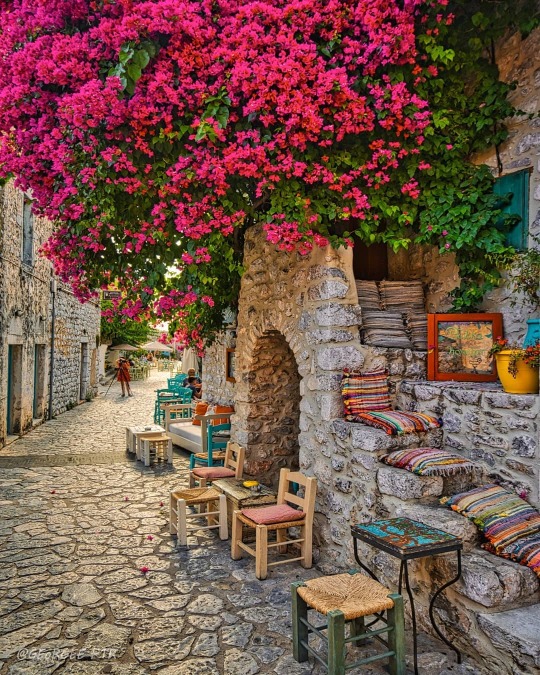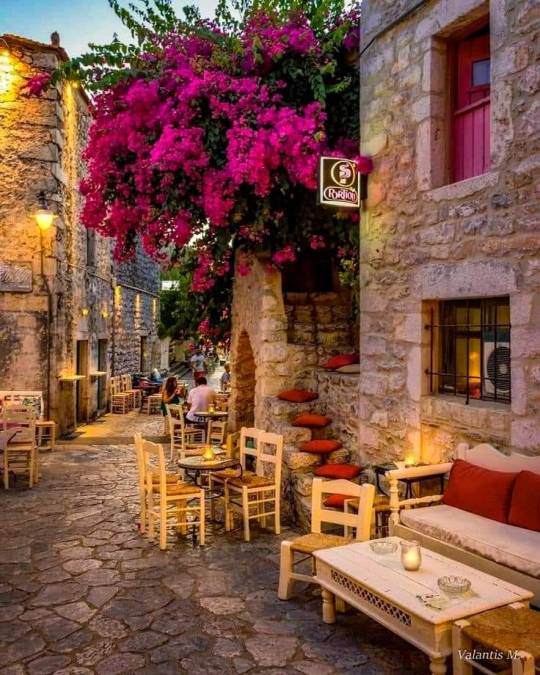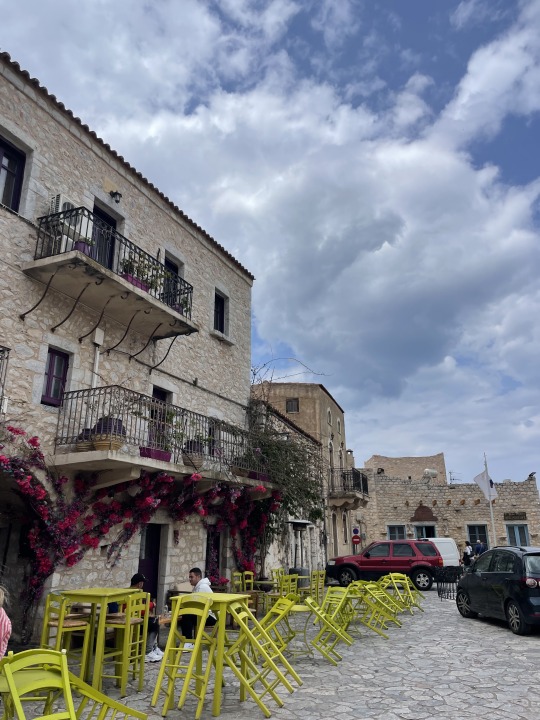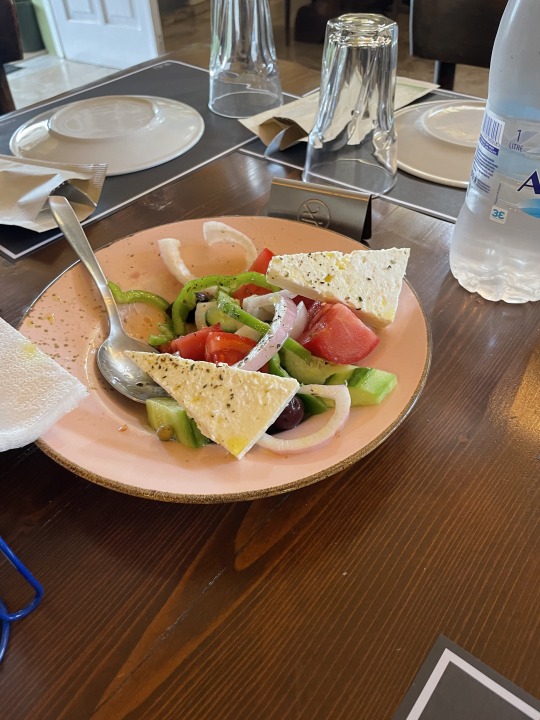#areopolis
Explore tagged Tumblr posts
Text

areopoli
© 2024 Yiannis Krikis
#areopoli#lensblr#lensculture#fine art photography#photographers on tumblr#landscape#greece#peloponnese#umbrella
170 notes
·
View notes
Text

Areopoli, Greece | Georgee
300 notes
·
View notes
Text

A r e o p o l i
209 notes
·
View notes
Text
📍Areopoli Mani,Greece🇬🇷
Is it the most beautiful settlement of Mani?
@grtravelwithme
Καλημέρα Ελλάδα 🇬🇷
8 notes
·
View notes
Text
2 notes
·
View notes
Text
Travels through History : The Peloponnese - Areopoli and Gythio
This is an excerpt from my forthcoming book called Travels through History : The Peloponnese. Extending south between the Messinian and Laconian Gulfs, the Mani Peninsula ends at Cape Matapan, the southernmost point of continental Greece. There was a naval battle off Matapan between the British and Australian navies on one side and the Italian navy on the other, between 27th and 29th March 1941.…
1 note
·
View note
Text
#tourisme#travel#voyage#travels#Grèce#Greece#Nauplie#Epidaure#théâtre antique#ruines#Monemvasia#souvlaki#gyros#vins#Gythio#Magne#mer#Vathia#Areopoli#sparte#Mystras#Péloponnèse#Stemnitsa#Olympie#Zeus#Naupacte#Delphes#Missolonghi#Parga
1 note
·
View note
Text

Areopoli divine village of Peloponnese in Greece. Photo by @minogiannisvalantis
Get Inspired, visit www.myhouseidea.com
#interior design#architecture#myhouseidea#home decor#decor home#kitchen#bedroom#houseidea#house idea#living
318 notes
·
View notes
Text
Areopoli, Greece 🇬🇷

230 notes
·
View notes
Text

areopoli
© 2024 Yiannis Krikis
#areopoli#lensblr#lensculture#fine art photography#photographers on tumblr#greece#landscape#people#peloponnese
86 notes
·
View notes
Text
The Best Things to Do in Mani, Greece
The picturesque region of Mani in Greece offers an extraordinary blend of natural beauty, historic charm, and cultural richness. Nestled in the southern part of the Peloponnese peninsula, Mani is renowned for its rugged landscapes, stunning coastlines, and traditional stone villages. This article will guide you through the top things to do in Mani, Greece, ensuring you experience what this enchanting region offers.
Explore the Historic Town of Areopoli
Areopoli, the vibrant heart of Mani, is a must-visit for anyone traveling to the region. Known for its traditional architecture and historic significance, Areopoli is where history comes alive. Wander through its narrow cobblestone streets, admire the well-preserved stone houses, and visit the impressive Church of the Taxiarchis, which boasts stunning Byzantine frescoes.
Cultural Highlights of Areopoli
Areopoli Museum: This museum showcases artifacts and exhibits related to Mani's local history and culture. It provides valuable insights into the region's past.
Lighthouse of Areopoli: Built in the 19th century, this lighthouse offers panoramic views of the surrounding landscape and the sea.
Discover the Scenic Beauty of the Diros Caves
The Diros Caves, located near the village of Pyrgos Dirou, are one of Greece’s most remarkable underground attractions. These caves are famous for their stunning stalactites and stalagmites and are accessible by boat, which adds to the adventure. The underground lake inside the caves provides a serene and mystical atmosphere.

Visiting Tips
Guided Tours: Opt for a guided tour to fully appreciate the geological formations and the cave’s history.
Comfortable Footwear: Wear comfortable, water-resistant shoes to navigate the cave paths easily.
Hike the Stunning Mani Peninsula Trails
Mani’s diverse landscape makes it a hiker’s paradise. The peninsula is dotted with numerous trails that offer breathtaking views of the Mediterranean Sea and rugged mountains. Notable hikes include:
Mount Taygetos: The highest peak in the Peloponnese, Mount Taygetos offers challenging trails and panoramic views from the summit.
The Coastal Trail from Areopoli to Limeni: This relatively easy hike provides stunning coastal views and the chance to explore quaint seaside villages.
Essential Hiking Information
Trail Maps: Obtain a map of the trails to ensure you stay on the right path.
Weather Check: Verify weather conditions before setting out to avoid unexpected challenges.
Relax on the Beautiful Beaches of Mani
Mani’s coastline is dotted with beautiful, unspoiled beaches. Whether you prefer a quiet cove or a more accessible beach, Mani has something for everyone. Key beaches to visit include:
Kalamitsi Beach: A serene spot with clear waters and golden sands, ideal for swimming and sunbathing.

Limeni Beach: Known for its crystal-clear waters and charming seaside tavernas, Limeni Beach is perfect for a relaxing day out.
Beach Tips
Sun Protection: Bring sunscreen and a hat to protect yourself from the sun.
Snorkeling Gear: Pack snorkeling equipment to explore the vibrant marine life.
Visit the Ancient Village of Vathia
Vathia is a captivating abandoned village that provides a glimpse into the past of Mani. Its traditional stone towers and homes are a testament to the region’s architectural heritage. The village’s desolate beauty is perfect for photography and exploring.

Key Attractions
Traditional Architecture: The stone towers and houses in Vathia are well-preserved examples of Mani’s traditional architecture.
Panoramic Views: Climb to the top of the towers for breathtaking views of the surrounding landscape.
Experience Local Cuisine
Mani’s cuisine is a delightful reflection of its culture. Traditional Greek dishes are prepared with locally sourced ingredients, offering an authentic taste of the region. Try local specialties such as:
Mani’s Olive Oil: Renowned for its quality, Mani’s olive oil is a staple ingredient in many dishes.
Local Mezes: Enjoy a variety of appetizers like olives, cheeses, and cured meats at local tavernas.
Dining Recommendations
Tavernas in Areopoli: Experience authentic Greek cuisine in the charming tavernas of Areopoli.
Seaside Restaurants in Limeni: Enjoy fresh seafood while overlooking the beautiful sea.
Discover the Hidden Gem of Stoupa
Stoupa is a small coastal village that offers a relaxing escape from the hustle and bustle. With its beautiful beaches, charming shops, and quaint cafes, Stoupa provides a perfect setting for a leisurely day.

Things to Do in Stoupa
Visit the Beach: Stoupa’s main beach is ideal for swimming and sunbathing.
Explore Local Shops: Browse through local shops for unique souvenirs and gifts.
Conclusion
Mani, Greece, is a region of captivating beauty, rich history, and vibrant culture. From exploring historic towns and ancient villages to relaxing on pristine beaches and hiking scenic trails, there is something for every traveler. This diverse range of activities ensures a memorable visit to one of Greece’s most charming destinations.
FAQs What is the best time to visit Mani?
The best time to visit Mani is spring (April to June) or autumn (September to October). The weather is pleasant, and you can avoid the summer crowds.
How can I get to Mani?
Mani can be reached by car from Athens, about a 3-hour drive. Alternatively, you can take a bus from Athens to Kalamata and then drive to Mani.
Is Mani suitable for families with children?
Yes, Mani is suitable for families. The region offers family-friendly beaches, easy hiking trails, and cultural sites for children.
Website | Facebook | Instagram | Medium | Quora
0 notes
Text

THE DESCRIPTION OF POPE SAINT JOHN XXIII Feast Day: October 11
"This is the rosary of Mary, considered in its various elements, which are linked together in vocal prayer and woven into it, as in a delicate and rich embroidery, full of spiritual warmth and beauty." -excerpt from The Holy Rosary. P 360, Journal of a Soul
When on October 20, 1958, the cardinals, assembled in conclave, elected Angelo Roncalli as pope many regarded him, because of his age and ambiguous reputation, as a transitional pope, little realizing that the pontificate of this man of 76 years would mark a turning point in history and initiate a new age for the Church. He took the name of John in honor of the precursor and the beloved disciple—but also because it was the name of a long line of popes whose pontificates had been short.
Angelo Giuseppe Roncalli, the third of thirteen children, was born on November 25, 1881 at Sotto il Monte (Bergamo) of a family of sharecroppers. He attended elementary school in the town, was tutored by a priest of Carvico, and at the age of twelve entered the seminary at Bergamo. A scholarship from the Cerasoli Foundation (1901) enabled him to go on to the Apollinaris in Rome where he studied under (among others) Umberto Benigni, the Church historian. He interrupted his studies for service in the Italian Army but returned to the seminary, completed his work for a doctorate in theology, and was ordained in 1904. Continuing his studies in canon law he was appointed secretary to the new bishop of Bergamo, Giacomo Radini-Tedeschi. Angelo served this social-minded prelate for nine years, acquiring first-hand experience and a broad understanding of the problems of the working class. He also taught apologetics, church history, and patrology.
With the entry of Italy into World War I in 1915, he was recalled to military service as a chaplain. On leaving the service in 1918 he was appointed spiritual director of the seminary, but found time to open a hostel for students in Bergamo. It was at this time also that he began the research for a multi-volume work on the episcopal visitation of Bergamo by St. Charles Borromeo, the last volume of which was published after his elevation as pope.
In 1921, he was called to Rome to reorganize the Society for the Propagation of the Faith. Nominated titular archbishop of Areopolis and apostolic visitator to Bulgaria (1925), he immediately concerned himself with the problems of the Eastern Churches. Transferred in 1934 to Turkey and Greece as apostolic delegate, he set up an office in Istanbul for locating prisoners of war. In 1944 he was appointed nuncio to Paris to assist in the Church's post-war efforts in France, and became the first permanent observer of the Holy See at UNESCO, addressing its sixth and seventh general assemblies in 1951 and 1952. In 1953 he became cardinal-patriarch of Venice, and expected to spend his last years there in pastoral work. He was correcting proofs of the synodal Acts of his first diocesan Synod (1958) when he was called to Rome to participate in the conclave that elected him pope.
In his first public address Pope John expressed his concern for reunion with separated Christians and for world peace. In his coronation address he asserted 'vigorously and sincerely' that it was his intention to be a pastoral pope since 'all other human gifts and accomplishments—learning, practical experience, diplomatic finesse—can broaden and enrich pastoral work but they cannot replace it.'
One of his first acts was to annul the regulation of Sixtus IV limiting the membership of the College of Cardinals to 70; within the next four years he enlarged it to 87 with the largest international representation in history.
Less than three months after his election he announced that he would hold a diocesan synod for Rome, convoke an ecumenical council for the universal Church, and revise the Code of Canon Law. The synod, the first in the history of Rome, was held in 1960; Vatican Council II was convoked in 1962; and the Pontifical Commission for the Revision of the Code was appointed in 1963.
His progressive encyclical, Mater et Magistra, was issued in 1961 to commemorate the anniversary of Leo XIII's Rerum novarum. Pacem in terris, advocating human freedom and dignity as the basis for world order and peace, came out in 1963. He elevated the Pontifical Commission for Cinema, Radio, and Television to curial status, approved a new code of rubrics for the Breviary and Missal, made notable advances in ecumenical relations by creating a new Secretariat for Promoting Christian Unity and by appointing the first representative to the Assembly of the World Council of Churches held in New Delhi (1961). In 1960 he consecrated fourteen bishops for Asia, Africa, and Oceania. The International Balzan Foundation awarded him its Peace Prize in 1962.
Since his death on June 3, 1963, much has been written and spoken about the warmth and holiness of the beloved Pope John. Perhaps the testimony of the world was best expressed by a newspaper drawing of the earth shrouded in mourning with the simple caption, 'A Death in the Family.'
Source: vatican.va
1 note
·
View note
Text
Day 9!! Today was a long travel day, so we spent a lot of time on the bus. After we saw the caves, we drove to a town called Areopolis on the way to the olive oil tasting and Olympia. When we first arrived, we went on a walk around the town and got to see all the gorgeous stone the buildings and streets are made of. We learned about the critical role this town played in the start of the war against the Ottoman Empire.

After the short walking tour, we went and ate lunch. We started out with some bread, a Greek salad with cucumber, tomato, onion, bell peppers, olives, and feta cheese. We also got to try these cheese croquettes with a sweet jam. For the main dish, I had pastitsio, which is a traditional Greek dish of baked pasta, ground beef, and a bechamel sauce. Some other people got the moussaka, which is also a traditional Greek dish with eggplant, potatoes, ground beef, and bechamel sauce. Everything we ate was so good!! After lunch, we continued on our drive to Olympia. On the way, we stopped at a rest stop that had a bakery with amazing baked goods and treats. I got a little pastry that was essentially a mini baklava with nuts and honey, which was so amazing! The baklava has been my favorite dessert I’ve had while here! Such a good day of eating!
-Caroline Huettner




1 note
·
View note
Text
Areopoli is a town on the Mani Peninsula, Laconia, Greece. The word Areopoli, which means "city of Ares", the ancient Greek god of war, became the official name in 1912.

92 notes
·
View notes
Text
Travels through History : The Peloponnese - Areopoli and Gythio
This is an excerpt from my forthcoming book called Travels through History : The Peloponnese. Extending south between the Messinian and Laconian Gulfs, the Mani Peninsula ends at Cape Matapan, the southernmost point of continental Greece. There was a naval battle off Matapan between the British and Australian navies on one side and the Italian navy on the other, between 27th and 29th March 1941.…
#areopoli#Greece#Greek#gythio#history#travel#what is there to do#what is there to do in#what is there to see in#what to do#what to do in#what to see#where to find#where to go#why go to
0 notes

